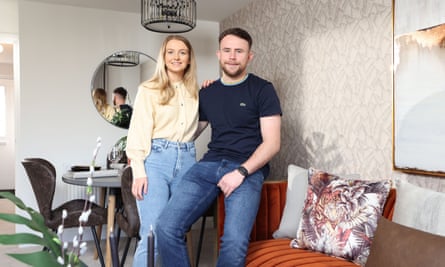Spring is traditionally a busy time in the housing market. This year, it comes after months of frantic activity fuelled by stamp duty tax breaks, making it difficult to predict how many buyers and sellers will be hitting the market as lockdowns start to ease around the UK.
The good news for potential first-time buyers is that they will soon have a bigger choice of mortgages that only require a 5% deposit. That’s because a government scheme to bring back 95% home loans officially goes live in just over a week’s time, with leading banks effectively ordered to take part. This month, too, the help-to-buy scheme was overhauled, and is targeted only at new entrants to homeownership.
Here we look at options open to first-timers looking to get a foot on the property ladder.
How to get the property you want: expert tips for first-time buyers Read more
95% mortgages
The number of deals requiring only a 5% deposit fell off a cliff when the pandemic struck, but they are starting to trickle back. As of Thursday, there were at least eight banks and building societies offering standard 95% deals, including the Coventry and Skipton building societies, Accord Mortgages (part of Yorkshire building society) and Bank of Ireland UK.
Things will really move up a gear when an official scheme aimed at increasing the availability of 95% mortgages goes live on 19 April. The chancellor, Rishi Sunak, has rather forced the banks’ hands by publicly announcing that Lloyds, NatWest, Santander, Barclays and HSBC will all be offering them this month.
The scheme, announced in the March budget, will give banks and building societies the chance to buy a guarantee on the riskiest portion of the mortgage – the bit between 80% and 95% loan-to-value (LTV). The government would cover that chunk of the lender’s losses if a home had to be repossessed after a property crash.
It may make sense to wait a week or two if you can, to see what the new deals look like.
Of the 95% deals available now, Nick Morrey, the product technical manager at the mortgage broker John Charcol, highlights the 3.89% five-year fixed rate offered by Coventry building society. This deal carries a £999 product fee.
While welcome to some, 95% mortgages will not solve the problems faced by buyers where house prices are high
Otherwise, Bank of Ireland UK has a two-year fix at 3.99% and a five-year one at 4.05%, in both cases with no product fee. Skipton has a two-year fix at 3.95% and a five-year deal at 4.09%, with no fees.
Accord, meanwhile, has a five-year fix, only available to first-time buyers. It is priced at 3.99% and has a £995 product fee.
90% mortgages
While welcome to some, 95% mortgages will not solve the problems faced by buyers in areas where house prices are high. Before offering a home loan, a lender will check that you can afford the monthly repayments.
The average deposit that a first-time buyer needs for a 95% mortgage in England is £11,087, while the average salary required is £46,800, according to an analysis by the law firm Quittance Legal Services. However, the figures for London are much higher: £21,682 and £91,500 respectively. Buyers who earn less will need to put together a bigger deposit to pass the affordability checks.
For anyone who can put down more, mortgage rates are lower. At 90% LTV, Virgin Money has a two-year deal at 3.18% and a five-year fixed-rate deal at 3.41%, both with a £995 fee. At 85% LTV, there are two-year rates at about 2.55% from Virgin Money, Leeds building society and NatWest, and five-year deals at about 2.8% from Virgin Money and NatWest, all with fees of just under £1,000.
Financial assistance provided by the bank of mum and dad, encompassing parents, grandparents, other family and friends, will help some first-time buyers get a deposit together. This sort of help is known in the mortgage industry as a gifted deposit. The borrower will typically have to prove the money is a gift and not a loan. A lot of lenders will accept these, though they may well ask for a “gifted deposit letter” to be completed and signed by the person giving the cash. If the person who gives you the money dies within seven years, you will have to pay inheritance tax on it.
 View image in fullscreenFinancial assistance from family and friends could help you get the property you want. Illustration: Ryan Gillett
View image in fullscreenFinancial assistance from family and friends could help you get the property you want. Illustration: Ryan Gillett
The help-to-buy equity loan scheme
The latest version of this scheme went live in December and is due to run until 2023. It is a loan from the government that you put towards the cost of buying a newly built home.
In England, under help to buy you can borrow from 5% up to 20% of the full purchase price, or up to 40% in London. This means you will need a smaller mortgage, which will be easier to afford. In London, those getting the full equity loan only need a mortgage of 55%. However, be aware that typically the mortgage lender will factor in 3% of the equity loan as a financial commitment when calculating affordability. So the bigger the equity loan you take out, the bigger the monthly outgoing that will be recorded.
The relaunched scheme has regional caps on prices. In London it can be used to buy a property costing up to £600,000, and the caps vary across England – from £186,100 in the north-east to £437,600 in the south-east.
The loans granted through the scheme are interest-free for the first five years – you will begin to pay interest from year six. The loan can be repaid at any time but must be settled when the home is sold or the mortgage is paid off.
Buyers pay a reservation fee of up to £500 and need to pay a 5% deposit on exchange of contracts.
In Wales, there is a help-to-buy scheme offering a shared equity loan to buyers of new-build homes. In Scotland, applications are still being accepted to its help-to-buy smaller developer scheme.
 View image in fullscreenGetting the money for a deposit can seem daunting, but there are ways to do it. Illustration: Ryan Gillett
View image in fullscreenGetting the money for a deposit can seem daunting, but there are ways to do it. Illustration: Ryan Gillett
Shared ownership
With house prices so high, this has been promoted as an affordable option that can give people a foot on the property ladder at a lower cost. But critics say there are plenty of potential downsides.
You buy a share of a new build or resale property – usually between 25% and 75% – and pay rent on the share that you do not own. If it is a flat, you will also have to pay a service charge for the maintenance of the building.
One advantage of the scheme is that because the buyer only needs a mortgage for the share they are purchasing, the deposit needed is usually a lot smaller than for a standard home purchase. The rent is less than the rate charged on the open market – typically about 2.75% of the property’s value per year.
However, some shared owners have encountered problem with escalating service charges, allegedly poor-quality building maintenance, costly lease extension processes and restrictions on the lease that can make selling up difficult.
A big advantage is that you have the option to buy further shares – up to 100% ownership in most instances – if you wish. This is known as staircasing. However, staircasing rates are thought to be fairly low. A YouGov survey of more than 200 shared-ownership buyers carried out in late 2018 found that almost 90% had not staircased at all in their current property, with the majority saying they could not afford to.
To be eligible for shared ownership, you need to have an annual household income of less than £80,000 – or less than £90,000 in London. Some housing associations and local boroughs have their own terms regarding who is prioritised and affordability.
The Share to Buy website has a tool that lets you search for shared ownership properties.
 View image in fullscreenDon’t be daunted by the difficulties of buying a property – there are ways to do it. Illustration: Ryan Gillett
View image in fullscreenDon’t be daunted by the difficulties of buying a property – there are ways to do it. Illustration: Ryan Gillett
Guarantor and family mortgages
With Lloyds Bank’s Lend a Hand mortgages, you can borrow up to 100% of the purchase price. No borrower deposit is required – instead, a family member puts 10% of the purchase price into a three-year fixed-rate savings account to act as security. The mortgage will be fixed at 3.25% for three years. When that time is up, your family member will get their savings back with interest, as long as your mortgage repayments have all been made. You need to be a first-time buyer who is living and buying a home in England or Wales, and this cannot be used for interest-only mortgages, new build, right to buy, shared equity or shared ownership.
There is also the very similar Family Springboard mortgage from Barclays. Again, you do not need a deposit – you can borrow the full purchase price because your helper (who can be a family member or friend) provides 10% as security, in this case for five years. The money sits in a Barclays Helpful Start savings account. There are currently two mortgage deals on offer, both fixed for five years: 3.45% up to 95% LTV, and 3.65% up to 100% LTV. The property and borrower must be in the UK.
Meanwhile, Tipton & Coseley building society’s Family Assist mortgage lends at 100% LTV and involves a family member accepting a 20% charge on their own property or putting 20% of the amount being borrowed into a special savings account. The mortgage is a discounted-rate deal where you currently pay 3.39%.
Several other building societies also offer Family Assist mortgage deals that let people borrow up to 100%, including the Buckinghamshire (rates start at 3.29%) and the Mansfield (rates from 3.05%).
Others with similar deals include the Loughborough and Family building societies.
Rent-to-buy schemes
Rentplus is probably the leading provider of rent-to-buy housing aimed at helping lower-income households on to the property ladder without a deposit. With Rentplus, you pay an affordable rent on a new-build home for between five and 20 years and save for a deposit to buy the property.
It works with local authorities and housing associations (it does not allocate homes directly to tenants) and its residents are usually key or essential workers with a link to the local area.
‘The new help-to-buy scheme made all the difference’
Chelsea Grimwood and Mitchell McDonagh are using the government’s help-to-buy scheme to buy their first property.
The couple, who are both 25, have just bought a three-bedroom home at a Barratt Homes’ development in Chertsey, Surrey, and plan to move in this September.
At the moment they are living separately with their parents, who live on the same street close to Heathrow airport.
 View image in fullscreenChelsea Grimwood and Mitchell McDonagh have bought a three-bedroom property in Surrey. Photograph: PR
View image in fullscreenChelsea Grimwood and Mitchell McDonagh have bought a three-bedroom property in Surrey. Photograph: PR
Grimwood, who works for a mortgage broker, says: “We always knew that 2021 was the year we wanted to move out but thought it would be much later on in the year. We really didn’t expect to be able to buy a house so quickly but we used the new help-to-buy scheme, which meant we only needed to put down a 5% deposit, which we had saved during the last few months.
“This made all the difference as it would have been impossible for us to save up a 10% or 15% deposit – we would have probably just given up!”
The couple put down a deposit of £21,500 for their property, which they bought off-plan.
“It’s been tough, with the seemingly endless restrictions and lockdowns, but we decided to use the time to really knuckle down with saving for a house deposit,” Grimwood says. “We would usually go out most weekends or go on holiday but as we haven’t been able to do these things, we have been able to put away so much more each month. Living with our parents was a huge help, too, and we are fortunate that we could build our deposit so quickly.”
A number of new homes are available to NHS employees through Barratt’s NHS 5% Deposit Scheme
Lynnette St-Quintin, the sales and marketing director for Barratt southern counties, says: “We have seen high volumes of first-time buyers in recent months who are now able to get on to the property ladder sooner than anticipated thanks to the extra cash they have built up in part due to national restrictions.”
Grimwood says they are keen to “put our own stamp” on the house, and plan to use the next few months to save up for things such as furniture.
A number of new homes are available to NHS employees through Barratt’s NHS 5% Deposit Scheme, which was launched last year to say thank you to health service workers on the Covid frontline. Under the scheme, all NHS workers who buy a new Barratt Homes property in England, Wales or Scotland are being offered 5% of the purchase price to go towards their deposit, up to a maximum of £15,000. So for a home costing £200,000, the buyer would qualify for a contribution of £10,000.
All rates correct at time of writing



